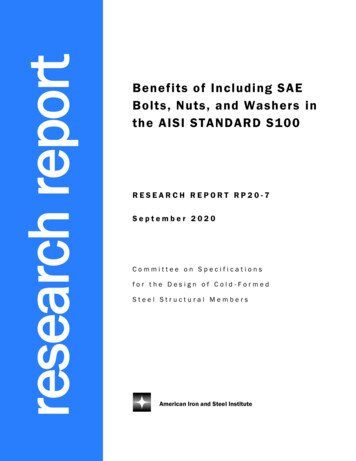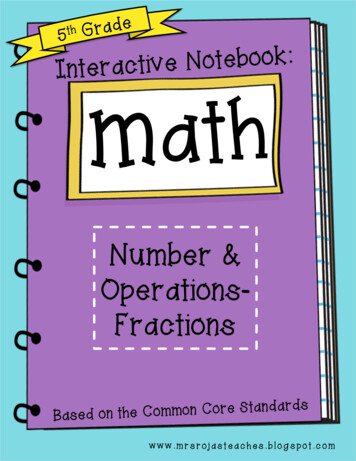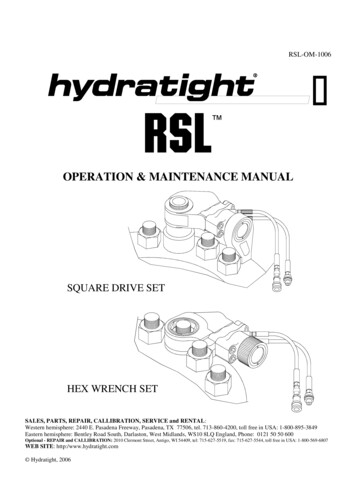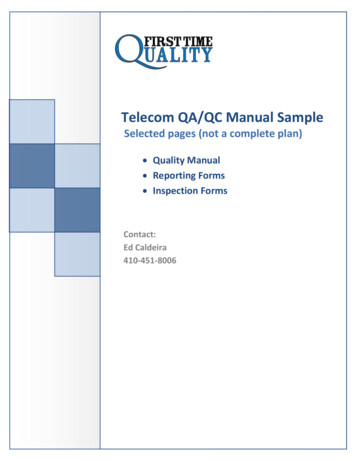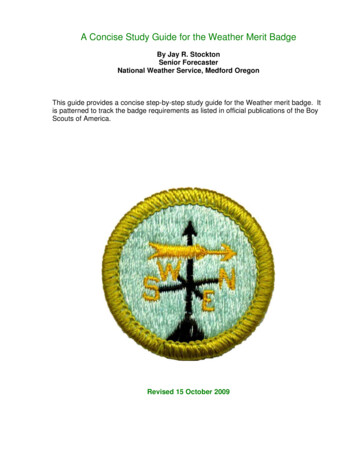
Transcription
5th Grade Earth Science:Weather UnitCover photo credit: Lauren GreeneDeveloped for Chapel Hill Carrboro City SchoolsNorthside Elementary School Outdoor Wonder & Learning (OWL) InitiativeUnless otherwise noted, activities written by:Toni Stadelman, Dana Haine, Lauren Greene, & Sarah YeltonCenter for Public Engagement with ScienceUNC Institute for the EnvironmentIn collaboration with 5th grade teachers at Northside Elementary School:Michelle Gay, Daila Patrick, & Elizabeth Symons
ACKNOWLEDGEMENTSMany thanks to Dan Schnitzer, Coretta Sharpless, Kirtisha Jones and the many wonderful teachers andsupport staff at Northside Elementary for their participation in and support of the Northside OWLInitiative. Thanks to Chip Konrad, UNC Professor and Director of the South East Regional Climate Centerfor sharing his time and resources during the development of this unit. Thanks also to Shelby Brown forher invaluable assistance compiling, editing, and proofreading the curriculum.Instructional materials and supplies to promote STEM-based outdoor learning were instrumental to thesuccessful implementation of this curriculum. The purchase of these materials was made possible withfunding provided by the Duke Energy Foundation to Chapel Hill-Carrboro City Schools.Curriculum developed June 2018 – July 2019For more information, contact:Sarah Yelton, Environmental Education & Citizen Science Program ManagerUNC Institute for the Environment Center for Public Engagement with Sciencesarah.yelton@unc.edu
5th Grade Weather UnitNorthside Outdoor Wonder & Learning Initiative
5th Grade Weather UnitOverarching Unit QuestionWhat is weather and how does it affect us?Essential QuestionsArc 1: What is weather and what factors influence the weather?Arc 2: How does the ocean affect our weather?Arc 3: How does weather affect our lives?Transfer GoalsUse scientific thinking to understand the relationships and complexities of the world around them.Identify real-world dilemmas and opportunities and apply scientific thinking to develop solutions for them.ooEnduring Understandings (Science)Weather impacts our lives and living conditions.Forecasting weather allows us to make decisions that influence the quality of our lives. Target Science Essential Standards5.E.1Understand weather patterns and phenomena, making connections to the weather in a particular placeand time.5.E.1.1 Compare daily and seasonal changes in weather conditions (including wind speed and direction,precipitation, and temperature) and patterns.5.E.1.2 Predict upcoming weather events from weather data collected through observation and measurements.5.E.1.3 Explain how global patterns such as the jet stream and water currents influence local weather inmeasurable terms such as temperature, wind direction and speed, and precipitation.5.P.2.1 Explain how the sun’s energy impacts the processes of the water cycle (including, evaporation,transpiration, condensation, precipitation and runoff).Secondary Target Standards (ELA, Math, Social Studies)ELARI.5.1 Quote accurately from a text when explaining what the text says explicitly and when drawing inferencesfrom the text.RI.5.4 Determine the meaning of general academic and domain-specific words and phrases in a text relevant toa grade 5 topic or subject area.RI.5.9 Integrate information from several texts on the same topic in order to write or speak about the subjectknowledgeably.W.5.2 Write informative/explanatory texts to examine a topic and convey ideas and information clearly.5th Grade Weather Unit1Northside Outdoor Wonder & Learning Initiative
W.5.3 Write narratives to develop real or imagined experiences or events using effective technique, descriptivedetails, and clear event sequences.MathNC.5.MD.2 Represent and interpret data. Collect data by asking a question that yields data that changes over time. Make and interpret a representation of data using a line graph. Determine whether a survey question will yield categorical or numerical data or data that changesover time.Unit OverviewThis unit is divided into 3 Arcs. Arc 1 answers the essential question, “What is weather and what factors influencethe weather?” The learning activities included in this arc guide students to use observation skills in order todescribe, explain, and predict weather patterns. Students will learn that the sun’s energy is the driving force of ourweather. They will complete activities to learn about wind, clouds, precipitation, temperature, and the role thewater cycle plays in our weather.In Arc 2, students examine the essential question, “How does the ocean affect our weather?” Students willcomplete activities to help them describe and explain the gulf stream, El Nino, La Nina, Sea and Land Breezes aswell as hurricanes.Arc 3 allows students to investigate the essential question, “How does weather affect our lives?” Students willcomplete activities to help them explain why our choices are based on the weather, as well as the impact thatclimate change as on ecosystems. During the culminating activity in Arc 3, students research how to prepare forextreme weather. Students have several opportunities to use their observations skills while working on theirnature journals.Duration14-19 days of 45 minute learning activitiesVocabulary*atmosphere, air mass, air pressure, condensation, evaporation, high pressure system, humiditylow pressure system, precipitation, prevailing winds, troposphere, water vapor, wind, weather, season, seasonal,cloud, cirrus, cumulus, nimbus, cumulonimbus, stratus, fog, anemometer, barometer, cold front, fronts, warmfront, occluded front, stationary front, rain gauge, thermometer, wind vane, El Nino, Gulf Stream, Jet Stream, landbreeze, La Nina, meteorologist, meteorology, sea breezes, climate, climate change, convection, radiation,conduction* Definitions of vocabulary words can be found on the arc overview pages. Relevant vocabulary is listed on eachlearning activity page.5th Grade Weather Unit2Northside Outdoor Wonder & Learning Initiative
Go Outdoors! Tips & ToolsTaking your class outside for science or any lessons can be rewarding and challenging. Along with behavior andmaterials management tips with each lesson, this section is intended to help you have the tools you need tosuccessfully take your class outside.Before You Go Outside Create ground rules with students for all outdoor lessons. Post the rules for students to be able to easily see.Ask for parent volunteers. Extra help can make an outdoor learning experience much more manageable.Teach students proper use, including safety, of the science tools they will be using.Set expectations before go. Give instructions both inside and repeat once outside.Have a clear objective for going outdoors. This will help focus students’ attention.Be flexible. Structure lessons to take advantage of opportunities and challenges.Establish a meeting spot and emergency plan. Have a signal for emergency situations.Take students outside for short exercises to practice rules before longer outdoor lessons.Use same door to always go outside for learning. Emphasize this is different than going outside for recess.While You Are Outside Model the activities and outdoor skills for students. Show them what you expect them to be doing.Participate in the activity. Get down on your students’ level. Get your hands dirty.Model respect for nature with your students.The outdoors is full of teachable moments. Use “I wonder” statements to engage students in questioning theexperience. Have students write down questions to be researched back in the classroom.Allow students to be leaders in the activity. Ask students to volunteer as teacher assistant or materials manager.Acknowledge that students want to explore and can do so once the assigned task is complete.Safety First! Scout outdoor areas ahead of time if possible, to note potential hazards such as poison ivy.Students should never be alone. If a student needs to go back to the building, send 2 students.Take a first aid kit and phone/walkie-talkie. Consider bringing along staff trained in first aid/CPR.Let office staff know where you and your class are going if headed out on a walking field trip.Stay on the trail/path, unless otherwise directed. On the greenway, stay on the right side of path.Do not eat wild plants, unless harvesting in the garden with a teacher.Set boundaries for the students to stay within. You have to be able to see me and I have to be able to see you!A Note on Nature JournalingNature journals that you use with your class should be small composition books or other blank books that studentsuse to make outdoor observations, including writing, drawing, and painting. Students can use colored pencils,watercolor pencils, or other materials to remember details of plants, animals, and habitats they are investigatingaround the schoolyard. This is different from a science notebook. However, some teachers may choose to havestudents paste blank pages into their science notebook to use for nature journaling pages.5th Grade Weather Unit3Northside Outdoor Wonder & Learning Initiative
Arc 1What is weather & what factorsinfluence the weather?Essential QuestionsWhat is weather and what factors influence the weather?NC Science Essential Standards – Unpacked Content5.E.1.1 Students know that weather can change from day to day and that many factors are measured to describeand predict weather conditions. (e.g., wind speed and direction, precipitation, temperature, and airpressure). Students know that in different latitudes and hemispheres there are different (and sometimesopposite) seasonal weather patterns.5.E.1.2 Students know that one can collect and compare weather data in order to predict the likelihood of aparticular weather condition occurring. Students know how to read basic weather instruments:thermometer, barometer, anemometer, wind vane, and rain gauge. Students also can identifyatmospheric conditions (presence and type of clouds [stratus, cirrus, cumulus], fronts) that are associatedwith predictable weather patterns. Students can make basic weather predictions using these skills.5.E.1.3 Students know that local weather conditions are influenced by global factors such as air and watercurrents. The jet stream is an air current in the upper atmosphere, located over North America that has apowerful influence on the weather conditions there. The jet stream flows from the west to the east andchanges location depending on global conditions. The Gulf stream is a warm water surface current in theAtlantic Ocean that moves from south of Florida up the eastern seaboard and then across the Atlantic. TheGulf stream moderates weather along the eastern seaboard, warming the air and land there during thecooler months. In the Pacific, there is an oscillation of water temperatures known as El Nino/La Nina. Thisoscillation impacts the climate of North and South America for long periods of time. Hurricanes are majorstorms that form over warm ocean water and are caused by global weather patterns5.P.2.1 Students know that the sun provides the energy that is a driving force for most biotic and abiotic cycles onthe surface of the earth. Students know that the sun’s energy fuels the water cycle and impacts differentaspects of the water cycle (evaporation, transpiration, condensation, precipitation).Lessons in this Arc Engaging Activity: Local Weather DataLearning Activity 1: The Earth’s Atmospheric LayersLearning Activity 2: Weather & the SeasonsLearning Activity 3: What Causes WindLearning Activity 4: When Air Masses MeetLearning Activity 5: What Moves Air MassesLearning Activity 6: Clouds & Their FormationLearning Activity 7: Clouds & WeatherLearning Activity 8: The Water Cycle & Weather5th Grade Weather Unit4Northside Outdoor Wonder & Learning Initiative
Go Outdoors!Nature Journal Connection Engaging Activity: Local Weather Data Learning Activity 6: Clouds & Their Formation Learning Activity 7: Clouds & Weather Engaging Activity: Local Weather DataLearning Activity 6: Clouds & Their FormationLearning Activity 7: Clouds & WeatherDuration6-8 days of 45 minute learning activitiesBackground InformationWeather is the state of the atmosphere at any given time and place with respect to wind, temperature,cloudiness, moisture, pressure, and other factors. Most of Earth’s weather occurs in the troposphere, the lowestlayer of the atmosphere. Earth’s atmosphere is made of a series of layers that surround the earth. It absorbsenergy that radiates from the earth’s surface. Without the atmosphere to insulate the earth, it would beuninhabitable. Air pressure, the force exerted on a surface by the weight of air, decreases as you move up in thetroposphere. Differences in air pressure cause the movement of air, otherwise known as wind. Prevailing windsare global winds that constantly blow in the same direction over a certain area of the earth. The jet stream is aseries of fast flowing air currents that can push air masses to other areas and influence weather patterns. The jetstreams are more active in the winter when there are wider ranges of temperature differences between arctic andtropical air masses. Air moves from areas of higher pressure to areas of lower pressure, resulting in various windspeeds. High pressure systems are associated with clear skies while low pressure systems are associated withdark clouds and precipitation. Weather is different from climate. Climate is dependent on the range of weatherover a period of time. Climate change occurs when changes in Earth's climate system result in new weatherpatterns, lasting for at least a few decades.An air mass is a body of air which has the same temperature and/or humidity throughout. Humidity is theamount of water vapor present in the air. A front is where two air masses of different densities meet. This canresult in a cold front, cold air replacing the warm air, or a warm front, warm air replacing the cold air. A cold frontresults in cool, dry air, while a warm front results in warmer, wetter air. A stationary front is where two frontsmeet but neither are strong enough to take over the other. There is also an occluded front, where a warm airmass is caught between two cooler air masses, pushing the warmer air upwards.Different patterns of weather and daylight throughout the year are used to distinguish between the fourseasons—fall, winter, spring, and summer. Seasons are caused when different parts of the earth receive differentamounts of daylight as the earth rotates around the sun on its tilted axis. Seasons are different, and sometimesopposite, depending on latitude and/or hemisphere. The equator is an imaginary line dividing the northern andsouthern hemisphere.When water is heated, it evaporates into a gas. When it cools, it condenses from a gas back into a liquid. Cloudsform when there is too much water vapor in the air. The water vapor condenses into tiny droplets that formclouds. Eventually, the water droplets become too heavy and fall to the ground in the form of precipitation. Thisis mainly in the form of rain, snow, sleet, or hail. Cirrus clouds are high altitude, feathery, thin clouds made of tinyice crystals. Cumulus clouds are low altitude, fluffy clouds that are often seen with hot weather. Nimbus cloudsare dark and produce precipitation. Cumulonimbus clouds are tall, dark clouds that bring thunderstorms. Stratusclouds are low, thin clouds that can bring light drizzles. Fog is a cloud of small air droplets suspended over theearth’s surface.5th Grade Weather Unit5Northside Outdoor Wonder & Learning Initiative
Basic weather instruments can be used to predict the weather. Some of which include, a rain gauge, thermometer,anemometer, barometer, and wind vane. A rain gauge measures the amount of liquid precipitation over a setperiod of time. A thermometer is used to measure temperature. An anemometer is used to measure the speed ofwind. A barometer measures air pressure. A wind vane is used to detect the direction wind is blowing. Ameteorologist uses these devices in order to forecast the weather. Meteorology is the branch of scienceconcerned with forecasting and understanding weather.Vocabulary An air mass is a body of air that has the same temperature and/or humidity throughout.Air pressure is the force exerted onto a surface by the weight of air.The atmosphere is the layer of air that surrounds the earth.Condensation is the changing of gas back to a liquid.The equator is the imaginary line drawn around the middle of the earth.Evaporation is when a liquid changes back into a gas (water to water vapor).The jet stream is a narrow band of air that flows from west to east around the earth at relatively highspeeds.A high-pressure system is a whirling mass of cool, dry air that generally brings fair weather and light winds.Humidity is a measure of the amount of water vapor in the air.A low-pressure system is a whirling mass of warm, moist air that generally brings stormy weather withstrong winds.Precipitation is any liquid or solid form of water that falls from the atmosphere: rain, snow, hail, or sleet.Prevailing winds are global winds that blow constantly from the same direction.Seasons are periods of time during the year marked by specific weather patterns and daylight hours,resulting from the earth's changing position with regard to the sun.The troposphere is the lower layer of the atmosphere. All weather occurs in the troposphere.Water vapor is created when liquid water turns into a gas form due to heat.Weather is the state of the atmosphere at a given time and place with respect to wind, temperature,cloudiness, moisture, pressure, and other factors.Wind is the movement of air caused by earth’s uneven heating of the land surfaces. Wind moves from highpressure to low pressure.Literature ConnectionsOnlineReadWorks.org: Introduction to Clouds The Four Core Types of Clouds How Clouds Form Ten Basic Clouds Dust of Snow-Robert Frost Let It Snow Winter Worries & Hazards What Happens When It Rains? Water, Water, EverywhereWonderopolis.org: Why does water take so long to warm up?5th Grade Weather Unit6Northside Outdoor Wonder & Learning Initiative
Engaging Activity: Local WeatherLesson Prep Make a Weekly Weather Chart using chart paper (template at end oflesson) Find an area outside where students can make observations withoutbeing disturbed by other students.Learning Objectives:Students will be able to understandthe factors that make up weather.Nutshell/Skills:Students can make observationsabout the weather.VocabularyWeatherScience Essential Standards:5.E.1.1, 5.E.1.2ProcedureTime:45 minutesIndependent Work Take students outside with their Nature Journals and tell them theywill be using their observation skills. Use the questions below as guiding questions:o What do you see?o Is the ground wet from rain or snow?o Is there frost on the ground or other objects?o Is there any snow or ice on the ground or on other objects?o Is it cloudy?o Is it windy?o Is it raining?o Is it snowing?o What do you feel?o Is the wind blowing? How hard is it blowing against yourskin?o Is the air hot or cold? Does the air feel dry or damp?o Do you feel sunshine on your skin? Nature Journaling prompt:o Record your observations about the weather and be sure to notethe condition of the sky. Based on your observations, predictwhat the weather might be like in a few hours.Teacher Materials:o Access to local weather data(WRAL)o Weekly Weather Charto Chart paperStudent Materials:o Nature JournalsMini-Lesson Ask students to share their observations from their nature journals. Explain to students that they were making observations about theweather. Ask students to define weather by using their observations. Show students the Weekly Weather Chart. Ask students why knowing what the weather conditions will be isimportant.5th Grade Weather Unit7Northside Outdoor Wonder & Learning Initiative
Guided Practice Hang the Weekly Weather Chart on the wall. Every day during the weather unit, sfill in the weather chart using local weather data from the WeatherChannel or other reliable source for local weather data (including the weather stations at Northside). This chart will be used to build observation skills and serve as a source of talking points throughout the unit. After looking at today’s forecast, ask students how their predictions in their Nature Journals compared.Independent Work Have students answer the following questions in their notebooks:o How does weather affect your daily activities at home? At school?Assessment Exit ticket: What is weather?Behavior Management Tips Discuss with students the importance of respecting nature both biotic and abiotic things. Examples includethings such as:o leave worms and other animals aloneo leave rocks, soil, and grass where you found themDefine the boundary for where the students can sit and work on their nature journaling prompt.5th Grade Weather Unit8Northside Outdoor Wonder & Learning Initiative
WeeklyWeather ChartDate & TimeCurrentPrecipitationTemperatureAmount5th Grade Weather UnitClouds(Yes or No)9Wind Speed(Anemometer)WindDirectionHumidityAir Pressure(Barometer)Northside Outdoor Wonder & Learning Initiative
Learning Activity 1The Earth’s Atmospheric LayersLesson Prep Preview the Layers of the Earth’s Atmosphere Diagram. Preview the U.S. National Weather Service Weather Launch Video. Preview the Interactive Virtual Ballooning to Explore the Atmosphere .Learning Objectives:To identify the atmospheric layerwhere our weather occurs.Nutshell/Skills:Students can identify the atmosphericlayer where our weather occurs.VocabularyAtmosphere, troposphere, weatherScience Essential Standards:5.E.1.1, 5.E.1.2ProcedureMini-Lesson Show students the Layers of the Earth’s Atmosphere Diagram.o Ask students to write down everything they notice about thisdiagram.o Then ask for some volunteers to share their observations. Writethese on the board. Explain to students that this is a diagram thatrepresents the atmospheric layers of the earth.o Ask them which layer has clouds. Then explain that all of ourweather happens in the troposphere. Show the U.S. National Weather Service Weather Launch Video. Show the students the Interactive Virtual Ballooning to Explore theAtmosphere.o Discuss what the numbers on the graph mean, in particular thatthe negative number mean cold temperatures.o Ask students, “What do you notice about the temperatures as theweather balloon changes in altitude?”ELA Essential Standards:RI.5.1Time:45 minutesTeacher Materials:o Layers of the Earth’s AtmosphereDiagramo U.S. National Weather ServiceWeather Launch Videoo Interactive Virtual Ballooning toExplore the AtmosphereStudent Materials:o Chromebooks or iPadso Troposphere overviewo Science notebookso PencilsIndependent Work Ask students to read the troposphere overview on the UCAR Centerfor Science Education site. In their science notebooks, ask students to write a 3-5 sentencesummary about the troposphere and draw a diagram of the Earth’satmospheric layers.Assessment The completed diagram and summary can serve as an assessment.Opportunities for Extended Learning1. Students could compare (and graph) temperature in Boone, NC with nearby Grandfather Mountain over thecourse of a few days to a week to see how temperatures compare at the different elevations.5th Grade Weather Unit10Northside Outdoor Wonder & Learning Initiative
Learning Activity 2Weather and SeasonsLesson Prep Make copies of the reading passage, “What Causes the Seasons?” andthe questions unless students are reading this online. Get chart paper.Nutshell/Skills:Students can explain why differenthemispheres have different weatherpatterns (seasons).VocabularySeasons, seasonal, weatherProcedureMini-Lesson: Give students 5 minutes to list everything they know about seasons. Ask them to turn and talk with a partner and share their lists. Then ask students to answer the following question in theirnotebooks. “What causes seasons?” Tell students you will discuss the answer to the question before classis over. Divide the class into 6 groups. Tell students they will watch a short video. Each group is responsiblefor taking notes on one specific word. Assign one of the followingwords to a group:o Rotationo Axiso Tilto Orbito Hemisphereso Seasons Explain to the students that each of these words relates to the Earth. Show students Scholastic’s StudyJams: “A Day on the Earth” (3:50) Give each group 5 minutes to discuss the notes they took about eachword. Draw two circles on chart paper. Label one Earth and the other theSun. Have each group come to the front and explain how their wordrelates to the Earth. Then have them draw and label how the wordrelates to the Earth. For example, draw a line through the Earth foraxis and label it. (You could draw the lines and then students couldlabel them.)5th Grade Weather UnitLearning Objectives:Students will be able to explain whydifferent hemispheres have differentweather patterns (seasons).11Science Essential Standards:5.E.1.1ELA Essential Standards:RI.5.1, RI. 5.4Time:45 minutesTeacher Materials:o Chart paperStudent Materials:o Science Notebookso “What Causes the Seasons”reading passage and questions-OR- students can read thepassage onlineo ChromebookNorthside Outdoor Wonder & Learning Initiative
Ask students:o In which hemisphere is North America located?o If North America is experiencing winter, what season is South America experiencing?o How do you know South America is experiencing summer?o “What causes seasons?Ask students to look at the answer they wrote in their notebooks for the question: “What causes seasons?”Ask them if their answer is correct. If not, then write the correct answer.Independent Work: Have students read “What Causes the Seasons?” and answer the questions for the passage. This is a passagefrom Readworks.org.Assessment: Exit ticket: “What causes seasons?” and “What season is the Southern hemisphere experiencing now?”Opportunities for Extended Learning1. Show the students the interactive “Why Do We Have Seasons?”. Demonstrate how the interactive works.2. Have students answer questions for “Why do We Have Seasons?”. Answer key for questions for “Why DoWe Have Seasons?”.5th Grade Weather Unit12Northside Outdoor Wonder & Learning Initiative
Name:Date:Why Do We Have Seasons?Go to the “Why Do We Have Seasons?” interactive, (http://bit.ly/2Uh65IT)Once you click on launch, you will see tabs on the left side. Click on each tab to answer the followingquestions:About Seasons:1.What causes day and night?2.What causes the seasons?3.What are seasons?4.What are the four seasons?Earth’s Orbit:1.Does Earth’s orbit cause seasons?Sun’s Path in the Sky:1.Why does the sun appear to move across the sky from east to west?2.When does sunlight strike the Earth’s surface at a vertical angle?3.When does more solar energy reach the Earth’s surface?4.Does this make it warmer or colder?5.When does the Earth’s surface receive less energy from the sun?Sun’s Angle:1.Why does the Earth receive a small amount of energy?2.When is the sunlight more intense?3.When is the sunlight less intense?5th Grade Weather Unit13Northside Outdoor Wonder & Learning Initiative
ANSWER KEYWhy Do We Have Seasons?Go to the “Why Do We Have Seasons?” interactive, (http://bit.ly/2Uh65IT)Once you click on launch, you will see tabs on the left side. Click on each one of the tabsto answer the following questions:About Seasons:1. What causes day and night? Every day, Earth makes one rotation on its axis. Thiscauses day and night2. What causes seasons? Its axis always tilts in the same direction, so the parts of Earththat receive more direct sunlight and have more daylight hours change throughout the year.3. What are seasons? times of the year with particular patterns of weather and daylight,4. What are the four seasons? spring, summer, autumn, and winter.Earth’s Orbit:1. Does Earth’s orbit cause seasons? NoSun’s Path in the Sky:1. Why does the sun appear to move across the sky from east to west? because ofEarth's rotation2. When does sunlight strike the Earth’s surface at a vertical angle? When the Sun'sposition is higher in the sky at noon, there are more hours of daylight3. When does more solar energy reach the Earth’s surface? The higher the Sun appearsin the sky, the more solar energy reaches the surface.4. Does this make it warmer or colder? In general, this makes it warmer.5. When does the Earth’s surface receive less energy from the sun?6. Sun appears lower at noon, there are fewer hours of daylight and, since sunlight strikesless directly.Sun’s Angle:1. Why does the Earth receive a small amount of energy? Earth is small and far away,2. When is the sunlight more intense? When sunlight strikes Earth's surface more directly,3. When is the sunlight less intense? When sunlight strikes at a shallower angle and itspreads over a larger area.5th Grade Weather Unit14Northside Outdoor Wonder & Learning Initiative
Learning Activity 3What Causes Wind?Lesson Prep Gather enough materials for each student to have a small, clearplastic cup, a straw, and a pom pom. If possible, get an anemometer and wind vane. If not, then have apicture of anemometer and wind vane. Gather class set of blank US maps. Preview High Pressure Animation (NASA), Low Pressure Animation(NASA), Why is high pressure associated with fair, clear skies while lowpressure is associated with dark clouds and precipitation? (3:33), andEarth: A Global Map of Wind .VocabularyProcedureMini-Lesson: Air Pressure Activity Write the following questions on the board:o “What is wind?”o “What causes wind?”o Write their responses on the board.o Tell students that these questions and answers will be revisitedthroughout the lesson. Each student should be given a small clear plastic cup, a straw, and asmall pom pom. Have students
Sep 05, 2019 · Secondary Target Standards (ELA, Math, Social Studies) ELA . RI.5.1 Quote accurately from a text when explaining what the text says explicitly and when drawing inferences from the text. RI.5.4 . Determine the meaning of general academic and domain-specific words and phrases in a text relevant to
